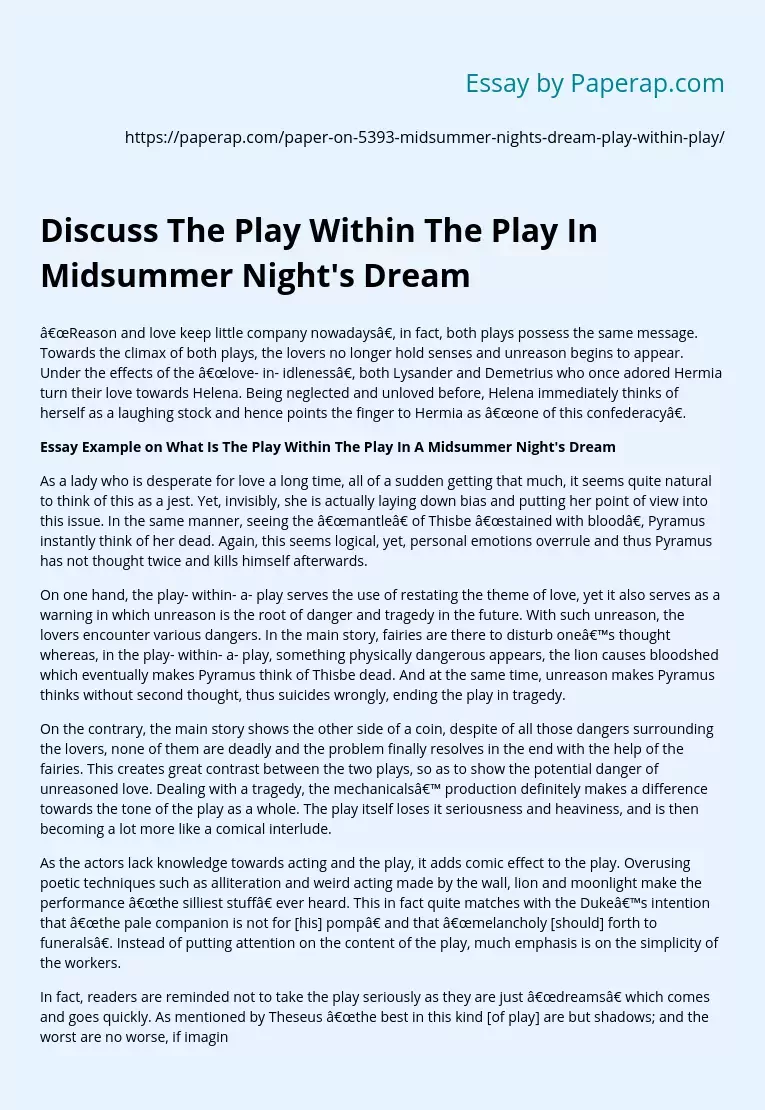Discuss The Play Within The Play In Midsummer Night's Dream
“Reason and love keep little company nowadays”, in fact, both plays possess the same message. Towards the climax of both plays, the lovers no longer hold senses and unreason begins to appear. Under the effects of the “love- in- idleness”, both Lysander and Demetrius who once adored Hermia turn their love towards Helena. Being neglected and unloved before, Helena immediately thinks of herself as a laughing stock and hence points the finger to Hermia as “one of this confederacy”.
Essay Example on What Is The Play Within The Play In A Midsummer Night’s Dream
As a lady who is desperate for love a long time, all of a sudden getting that much, it seems quite natural to think of this as a jest.
Yet, invisibly, she is actually laying down bias and putting her point of view into this issue. In the same manner, seeing the “mantle” of Thisbe “stained with blood”, Pyramus instantly think of her dead. Again, this seems logical, yet, personal emotions overrule and thus Pyramus has not thought twice and kills himself afterwards.
On one hand, the play- within- a- play serves the use of restating the theme of love, yet it also serves as a warning in which unreason is the root of danger and tragedy in the future. With such unreason, the lovers encounter various dangers. In the main story, fairies are there to disturb one’s thought whereas, in the play- within- a- play, something physically dangerous appears, the lion causes bloodshed which eventually makes Pyramus think of Thisbe dead.
And at the same time, unreason makes Pyramus thinks without second thought, thus suicides wrongly, ending the play in tragedy.
On the contrary, the main story shows the other side of a coin, despite of all those dangers surrounding the lovers, none of them are deadly and the problem finally resolves in the end with the help of the fairies. This creates great contrast between the two plays, so as to show the potential danger of unreasoned love. Dealing with a tragedy, the mechanicals’ production definitely makes a difference towards the tone of the play as a whole. The play itself loses it seriousness and heaviness, and is then becoming a lot more like a comical interlude.
As the actors lack knowledge towards acting and the play, it adds comic effect to the play. Overusing poetic techniques such as alliteration and weird acting made by the wall, lion and moonlight make the performance “the silliest stuff” ever heard. This in fact quite matches with the Duke’s intention that “the pale companion is not for [his] pomp” and that “melancholy [should] forth to funerals”. Instead of putting attention on the content of the play, much emphasis is on the simplicity of the workers.
In fact, readers are reminded not to take the play seriously as they are just “dreams” which comes and goes quickly. As mentioned by Theseus “the best in this kind [of play] are but shadows; and the worst are no worse, if imagination amend[s] them. ” Therefore, we should take the play lightheartedly as they are no more than visions. All in all, the “tedious brief scene” parallels with the main story as both plays deal with the obstacles of love and the unreason of love. Though the play- within- a- play ends tragically, it turns out to have a hilarious ending and matches with the play’s ending as well.
Discuss The Play Within The Play In Midsummer Night's Dream. (2019, Nov 27). Retrieved from https://paperap.com/paper-on-5393-midsummer-nights-dream-play-within-play/

